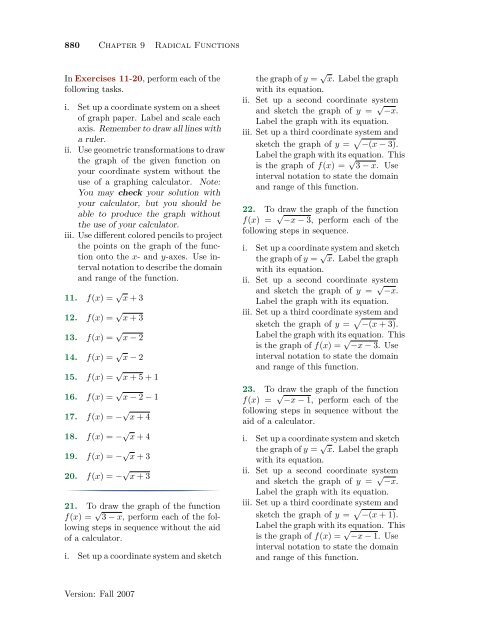Chapter 9: Exercises with Answers
Chapter 9: Exercises with Answers
Chapter 9: Exercises with Answers
You also want an ePaper? Increase the reach of your titles
YUMPU automatically turns print PDFs into web optimized ePapers that Google loves.
880 <strong>Chapter</strong> 9 Radical Functions<br />
In <strong>Exercises</strong> 11-20, perform each of the<br />
following tasks.<br />
i. Set up a coordinate system on a sheet<br />
of graph paper. Label and scale each<br />
axis. Remember to draw all lines <strong>with</strong><br />
a ruler.<br />
ii. Use geometric transformations to draw<br />
the graph of the given function on<br />
your coordinate system <strong>with</strong>out the<br />
use of a graphing calculator. Note:<br />
You may check your solution <strong>with</strong><br />
your calculator, but you should be<br />
able to produce the graph <strong>with</strong>out<br />
the use of your calculator.<br />
iii. Use different colored pencils to project<br />
the points on the graph of the function<br />
onto the x- and y-axes. Use interval<br />
notation to describe the domain<br />
and range of the function.<br />
11. f(x) = √ x + 3<br />
12. f(x) = √ x + 3<br />
13. f(x) = √ x − 2<br />
14. f(x) = √ x − 2<br />
15. f(x) = √ x + 5 + 1<br />
16. f(x) = √ x − 2 − 1<br />
17. f(x) = − √ x + 4<br />
18. f(x) = − √ x + 4<br />
19. f(x) = − √ x + 3<br />
20. f(x) = − √ x + 3<br />
21. To draw the graph of the function<br />
f(x) = √ 3 − x, perform each of the following<br />
steps in sequence <strong>with</strong>out the aid<br />
of a calculator.<br />
i. Set up a coordinate system and sketch<br />
the graph of y = √ x. Label the graph<br />
<strong>with</strong> its equation.<br />
ii. Set up a second coordinate system<br />
and sketch the graph of y = √ −x.<br />
Label the graph <strong>with</strong> its equation.<br />
iii. Set up a third coordinate system and<br />
sketch the graph of y = √ −(x − 3).<br />
Label the graph <strong>with</strong> its equation. This<br />
is the graph of f(x) = √ 3 − x. Use<br />
interval notation to state the domain<br />
and range of this function.<br />
22. To draw the graph of the function<br />
f(x) = √ −x − 3, perform each of the<br />
following steps in sequence.<br />
i. Set up a coordinate system and sketch<br />
the graph of y = √ x. Label the graph<br />
<strong>with</strong> its equation.<br />
ii. Set up a second coordinate system<br />
and sketch the graph of y = √ −x.<br />
Label the graph <strong>with</strong> its equation.<br />
iii. Set up a third coordinate system and<br />
sketch the graph of y = √ −(x + 3).<br />
Label the graph <strong>with</strong> its equation. This<br />
is the graph of f(x) = √ −x − 3. Use<br />
interval notation to state the domain<br />
and range of this function.<br />
23. To draw the graph of the function<br />
f(x) = √ −x − 1, perform each of the<br />
following steps in sequence <strong>with</strong>out the<br />
aid of a calculator.<br />
i. Set up a coordinate system and sketch<br />
the graph of y = √ x. Label the graph<br />
<strong>with</strong> its equation.<br />
ii. Set up a second coordinate system<br />
and sketch the graph of y = √ −x.<br />
Label the graph <strong>with</strong> its equation.<br />
iii. Set up a third coordinate system and<br />
sketch the graph of y = √ −(x + 1).<br />
Label the graph <strong>with</strong> its equation. This<br />
is the graph of f(x) = √ −x − 1. Use<br />
interval notation to state the domain<br />
and range of this function.<br />
Version: Fall 2007

















